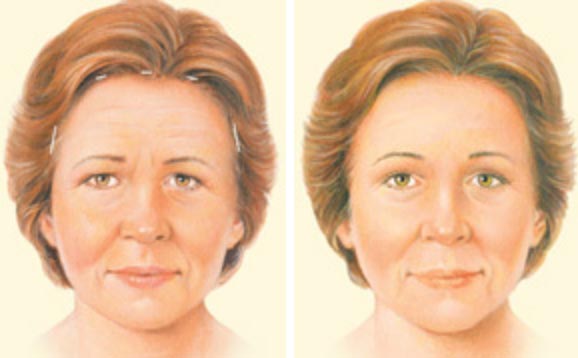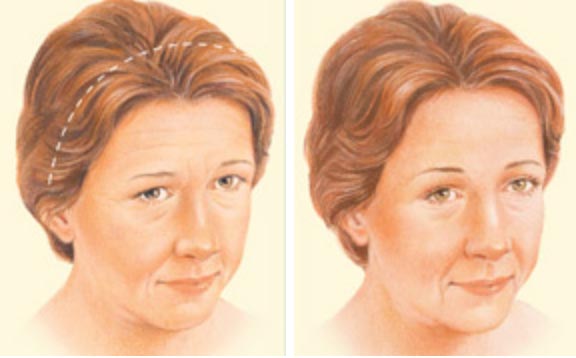Would You Like a Consultation?
Click the button to the right on your mobile phone to be connected with one of our friendly and knowledgeable staff and we will set up an appointment for you!
Also known as a forehead lift, brow lift surgery minimizes the creases that develop across the forehead, or those that occur high on the bridge of the nose; improves what are commonly referred to as frown lines; and repositions a low or sagging brow.
Enhancing your appearance with a brow lift
If you are bothered by expression lines or other signs of aging in the brow region, a brow lift may be right for you. A brow lift:
Rejuvenation procedures typically performed in conjunction with a brow lift include:
Is it right for me?
A brow lift is a highly individualized procedure and you should do it for yourself, not to fulfill someone else’s desires or to try to fit any sort of ideal image. Brow lift surgery is a good option for you if:
What happens during brow lift surgery?
Step 1 – Anesthesia
Medications are administered for your comfort during the surgical procedure. The choices include intravenous sedation and general anesthesia. Your doctor will recommend the best choice for you.
Step 2 – The incision
A brow lift may sometimes be performed using an endoscope (surgical video device) and special instruments placed through small incisions made within the hairline. This allows the tissue and muscle beneath the skin to be repositioned, altered or removed, correcting the source of visible creases and furrows in the forehead.
Correction of a low-positioned or sagging brow may be made with or without the use of an endoscope through incisions at the temples and in the scalp.
This technique may be done in conjunction with incisions hidden within the natural crease of the upper eyelids to eliminate frown lines between the brows, on or above the bridge of the nose.
An alternative brow lift technique is the coronal brow lift. The coronal brow lift can pinpoint specific regions of the brow to correct.
This technique involves an incision from ear to ear, lifting the forehead and removing excess skin from the scalp.
Recovery time is often longer than the endoscopic brow lift due to the size of the incision.

The incision lines from a brow lift are well concealed within the hair or natural contours of the face unless they are placed at the hairline to shorten the forehead.
Results appear gradually as swelling and bruising subside to reveal smoother forehead skin and a more youthful, restful appearance.
Step 3 – Closing the incisions
Brow lift incisions typically are closed with:

Step 4 – See the results
Brow elevation may be maintained by the use of:
The decision to have a brow lift is extremely personal and you’ll have to decide if the benefits will achieve your goals and if the risks and potential complications are acceptable.
Your plastic surgeon and/or staff will explain in detail the risks associated with surgery. You will be asked to sign consent forms to ensure that you fully understand the procedure you will undergo and any risks and potential complications.
The risks include:
Be sure to ask questions:
It’s very important to ask your plastic surgeon questions about your brow lift procedure. It’s natural to feel some anxiety, whether it’s excitement for your anticipated new look or a bit of preoperative stress. Don’t be shy about discussing these feelings with your plastic surgeon.
A special note about the use of fibrin sealants (tissue glue)
Fibrin sealants (made from heat-treated human blood components to inactivate virus transmission) are used to hold tissue layers together at surgery and to diminish post-operative bruising following surgery.
This product has been carefully produced from screened donor blood plasma for hepatitis, syphilis, and human immunodeficiency virus (HIV). These products have been used safely for many years as sealants in cardiovascular and general surgery. This product is thought to be of help in diminishing surgical bleeding and by adhering layers of tissue together.
When you go home
If you experience shortness of breath, chest pains, or unusual heart beats, seek medical attention immediately. Should any of these complications occur, you may require hospitalization and additional treatment.
The practice of medicine and surgery is not an exact science. Although good results are expected, there is no guarantee. In some situations, it may not be possible to achieve optimal results with a single surgical procedure. Another surgery may be necessary.
Be careful
Following your physician’s instructions is key to the success of your surgery. It is important that the surgical incisions are not subjected to excessive force, swelling, abrasion, or motion during the time of healing. Your doctor will give you specific instructions on how to care for yourself.
Click the button to the right on your mobile phone to be connected with one of our friendly and knowledgeable staff and we will set up an appointment for you!
When your procedure is completed, your forehead may be taped and your head may be loosely wrapped to minimize swelling and bruising. A thin tube may be present to drain any excess blood or fluid that may collect under the skin.
You will be given specific instructions that may include: How to care for the surgical site, medications to apply or take orally to aid healing and reduce the potential for infection, specific concerns to look for at the surgical site or in overall health, and when to follow up with your plastic surgeon.
Initial wound healing may take 5 to 10 days, at which time any sutures or clips will be removed. You will be ready to return to work and normal activity at this time. Cosmetics can camouflage any bruising that remains.
Healing will continue for several weeks as the swelling dissipates and incision lines refine and fade and it may take several months for your complete recovery.
Life-long sun protection will help to maintain your rejuvenated appearance by minimizing photo-aging or sun damage. In addition, a healthy lifestyle will also help extend the results of your rejuvenated, more youthful appearance.
Cost is always a consideration in elective surgery. Prices for brow lift surgeries can vary widely. A surgeon’s cost may vary based on his or her experience as well as geographic office location.
Many plastic surgeons offer patient financing plans, so be sure to ask. Cost may include:
Your satisfaction involves more than a fee
When choosing a plastic surgeon for brow lift surgery, remember that the surgeon’s experience and your comfort with him or her are just as important as the final cost of the surgery.
Most health insurance does not cover cosmetic surgery or its complications.